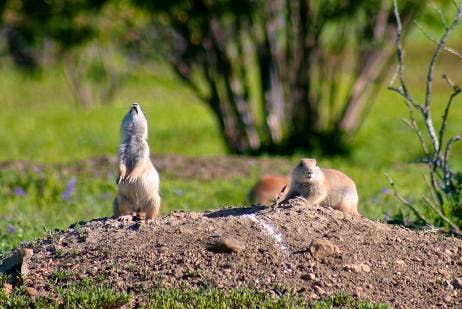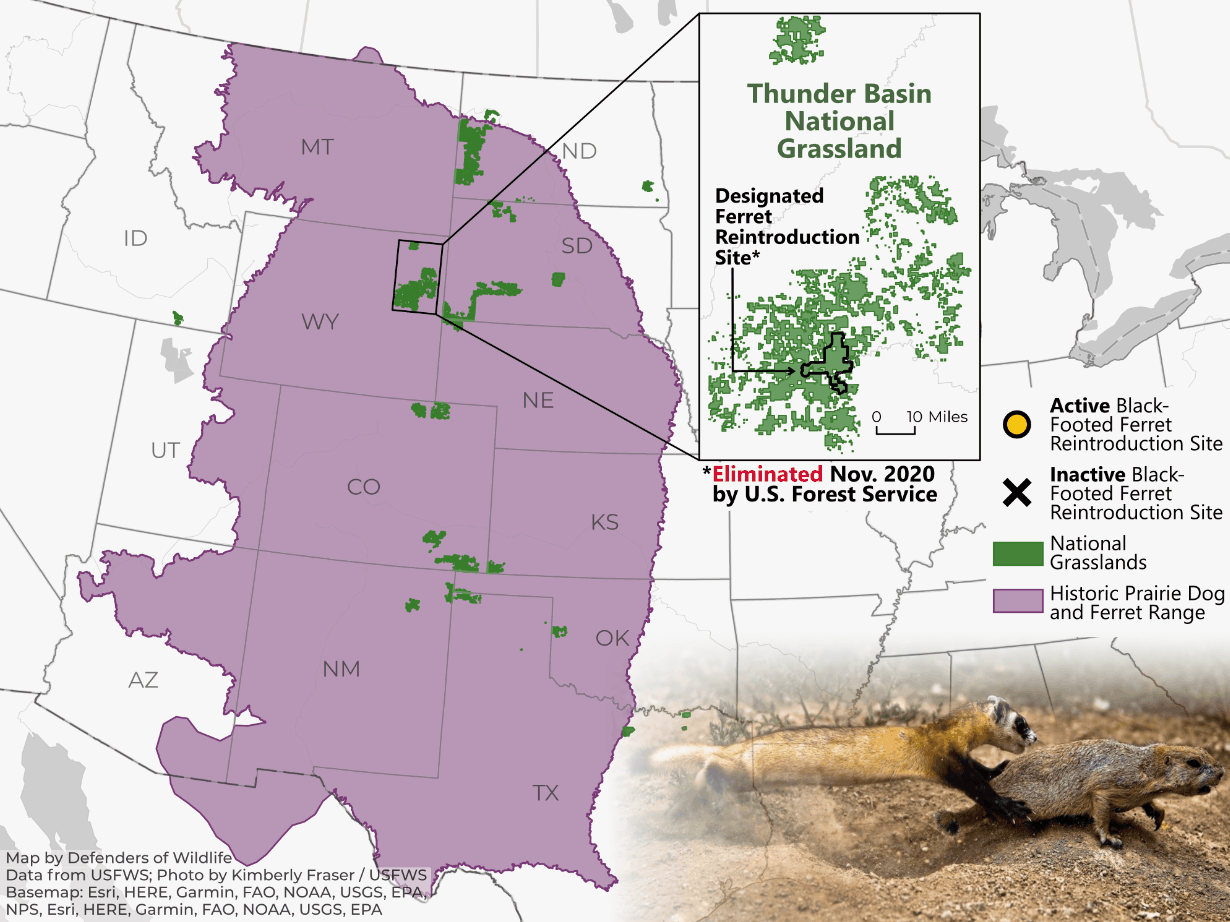Take a moment to imagine a masked predator stalking the prairie grasslands of the United States, hunting prey in the quiet blanket of the night. It’s likely you’re not picturing a small weasel, only 18 to 24 inches long and weighing barely a couple of pounds. This small carnivorous bandit is the black-footed ferret, native to the Great Plains with a remarkable story of perseverance to its name.
Declared extinct in 1979, black-footed ferrets today number about 400 individuals in the wild. In 1981, a dog named Shep made a surprise rediscovery on a ranch in Meeteetse, Wyoming, that led the U.S. Fish and Wildlife Service (FWS) to determine that about a dozen black-footed ferrets still existed in the wild. Biologists advocated for their protection under the Endangered Species Act (ESA), and captured the remaining animals to start a captive-breeding program at zoos around the country. The recovery program, now over 25 years old, is responsible for building up ferret populations and has reintroduced ferrets to 29 different locations in the United States, Canada and Mexico. Defenders is a proud sponsor of this recovery effort, conducting fieldwork and serving on the FWS Black-Footed Ferret Recovery Implementation Team. Recovery efforts require strict monitoring of ferrets s and the conservation of prairie dogs, so this work remains a priority. Black-footed ferrets can only be successfully released into grassland inhabited these other tunnel dwellers – prairie dogs.



More than 100 wildlife species depend on prairie dogs for survival – as a keystone species they create essential habitat and provide nutrients to the environment around them. Prairie dogs are the main food source for black-footed ferrets. Swift foxes, burrowing owls and Ferruginous hawks also pursue this common choice of prey. These ecosystem engineers additionally help provide for the health of the grassland with their extensive burrowing activity. Their digging activities clip the grasses short enough to promote nutritious regrowth and disturb soil to allow grass forbs to grow. The network of tunnels created by this skillful excavator serves as a refuge for grassland species. Black-footed ferrets spend almost 90% of their time underground, sleeping and raising their kits in abandoned prairie dog dens. Ferrets are nocturnal, leaving their dens at night to hunt.
It’s clear that the biodiversity of the prairie grasslands requires the continued survival of prairie dog colonies. Biodiversity is the web of connections among species that depend on each other for survival. The interactions between animals within a shared habitat will overlap and weave together to form a community. Attempting to remove prairie dog colonies is like trying to pull at a loose thread – the loss of this keystone species would cause the entire ecosystem to unravel.
The biggest threat to the survival of black-footed ferrets is sylvatic plague, which can wipe out entire prairie dog towns, causing ferrets to not only lose their food source but they can also be susceptible to the disease. Most importantly is the need for plague management and black-footed ferret vaccination to keep individual sites from succumbing to sylvatic plague epizootics.
Habitat loss is another catalyst that increases the likelihood of these connections to break by separating animal populations from each other and reducing the space available for feeding and reproduction. The United States has lost a devastating 95% of its historical prairie dog range since the mid-1800s because of the conversion of grasslands for cattle ranching. Mass poisoning of prairie dog colonies is another common practice, as local farming communities see them as a nuisance. Poisoning threatens native grassland birds, is expensive and offers a short-term solution without proper consideration of long-term ecosystem impacts. Despite the FWS stating that the Thunder Basin National Grassland is potentially the best possible site available for the successful reintroduction of the black-footed ferret, the Forest Service approved a proposal allowing the poisoning and shooting of prairie dogs by ranchers across the entire management area. This means only fraction of the previously protected colonies can be conserved for future ferret recovery. If this ruling went into effect, it would destroy all prairie dog colonies and ruin hopes of a fresh start for black-footed ferrets across Wyoming. Both species are also highly susceptible to disease such as the sylvatic plague, which can wipe out entire prairie dog colonies in a matter of days without proper mitigation techniques like vaccinations.
The current recovery program pairs black-footed ferret conservation with efforts to advance legislation that will protect vulnerable colonies of prairie dogs. Defenders has successfully helped to expand the range of sites available for reintroduction by conducting on-the-ground plague mitigation efforts and advocating for prairie dog protections at black-footed ferret sites in South Dakota, such as the Conata Basin in Badlands National Park and the Buffalo Gap National Grasslands. Nonlethal vegetation barriers are one of the coexistence tools we regularly employ to resolve prairie dog conflicts with landowners. Planting seeds produces vegetation barriers, while building snow fencing helps to trap moisture and encourages the growth of tall native grasses. Prairie dogs will naturally avoid traveling through these areas because they need clear visibility of their surroundings to avoid predators. In 2018, Defenders established a partnership with members of the local ranching community around Thunder Basin National Park to experiment with nonlethal alternatives to prairie dog poisoning, taking advantage of native seeds to preserve the integrity of the grassland ecosystem.
Promoting successful coexistence between stakeholders and imperiled species as well as creating integrated habitat management decisions requires listening to the concerns of ranchers and local residents. As Defenders of Wildlife, we therefore have the responsibility to use the science and litigation techniques at our disposal to speak up for animals who are voiceless. The fight to save the black-footed ferret is a testimonial to the necessity of protecting species in the context of their broader habitats. Animals do not exist independent of their surroundings, and it is the diversity of these prairie wildlife interactions that create productive ecosystems. The black-footed ferret cannot exist without prairie dogs, but neither species will be able to survive unless we prioritize the conservation of landscapes surrounding them.












